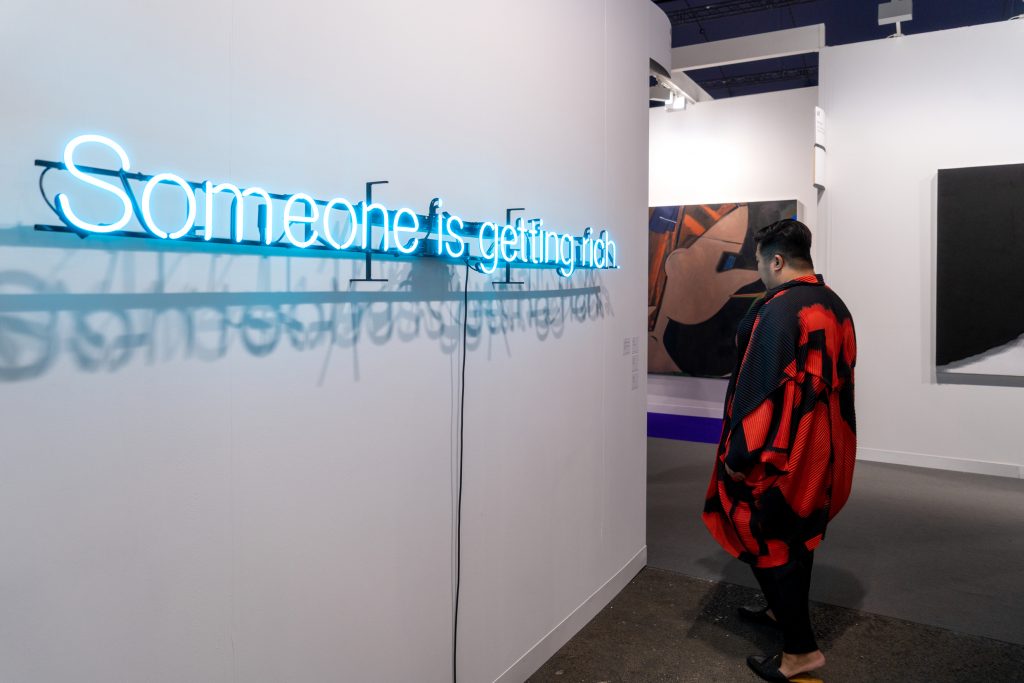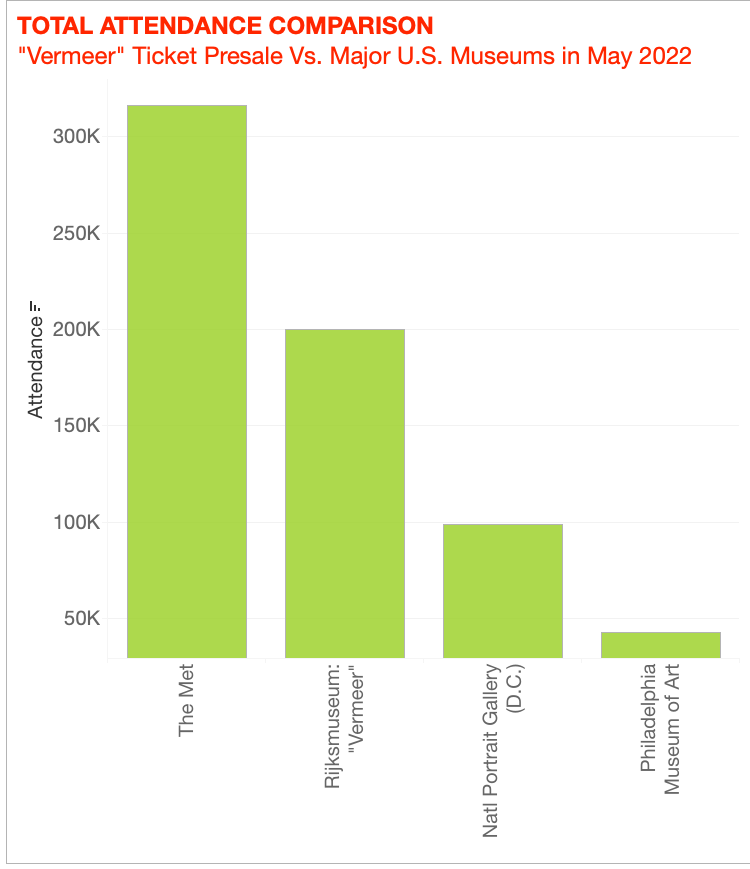The Back Room
The Back Room: Twilight of the Gmail Art Advisors
This week: good riddance to bad advisors, A-list poaching gossip, Vermeer as ticket master, and much more.

This week: good riddance to bad advisors, A-list poaching gossip, Vermeer as ticket master, and much more.

Artnet News

Every Friday, Artnet News Pro members get exclusive access to the Back Room, our lively recap funneling only the week’s must-know intel into a nimble read you’ll actually enjoy.
This week in the Back Room: good riddance to bad advisors, A-list poaching gossip, Vermeer as ticket master, and much more—all in a 7-minute read (1,824 words).
__________________________________________________________________________

A view at Paris+ par Art Basel 2022. Courtesy of Art Basel.
A correction in the art market isn’t great news for art advisors. But it’s much, much worse for “art advisors,” and this latter group appears to be in the midst of a true cataclysm right now.
Wondering about the distinction being drawn by those scare quotes? Let Katya Kazakina guide you. Last week, her column covered the phenomenon of what one source called “Gmail art advisors,” an unscrupulous, highly transactional breed that operates almost exclusively via email and social media.
Of this group (also known as “10 Percenters”), she writes…
“They leech onto the same hot emerging artists, helping to push their prices into millions of dollars. They get kickbacks from the galleries in exchange for bringing business from their clients, who also pay them. They are happy to flip works quietly without galleries finding out—because they know people who know people who own the works, and can make a cut, no matter how small, by selling them.”
With the bubble for some ultra-hot ultra-contemporary artists deflating before our eyes, Gmail art advisors seem to be disappearing left and right. Historically, that’s par for the course when easy commissions dry up and the work of advising gets hard.
Unlike, say, the 151 internationally approved members of the Association of Professional Art Advisors (APAA), the Gmailers have no interest in, or aptitude for, the less glamorous, long-term responsibilities of the trade. Think: carefully researching provenance, inspecting condition, dealing with the shipping and customs headaches that often come from buying abroad, and more.
Still, with their ranks in decline, it’s worth looking at the reasons for their predictable emergence (and retreat)…
The reality is that there are no degrees, training programs, licenses, or memberships needed to do business as an art advisor. Educational and professional credentials are strictly optional. All you really need is a few people willing to pay you for your services.
“Unlike being a stockbroker, which requires a rigorous process to get professionally certified, anyone could print up a business card that says ‘art advisor,’” said Alex Glauber, who built early professional experience by acquiring (and then liquidating) art for the Neuberger Berman and Lehman Brothers corporate collections.
This means practically anyone can set up shop as an advisor overnight if they smell money, have a decent risk tolerance, and can weasel their way into a reasonably attractive painting or two.
Gmail art advisors tend to be young (frequently, fresh out of college) and more interested in cash than art. This makes them highly similar to the types of new buyers they typically glom onto.
The difference is that the “advisors” are often related to an art dealer or collector, which gives them a point of entry into the system that their clients lack. So the two parties form “a symbiotic relationship that may be based on a shared transactional goal as much as sheer necessity,” Katya writes.
In other words, an influx of new cash into the economy leads to an influx of new art buyers with surface-level interest in the artwork itself; that, in turn, leads to an influx of new advisors with similar priorities and just enough connections to scrape together the same trend-following collection for all takers.
Both sides are using each other in a transparent way in an overheated market. But only the buyer is left holding the bag when a downturn hits and their collection drops in value by, oh, 90 percent.
Payment schemes for art advisors vary. Retainers used to be common, but there has been a shift toward taking commissions based on the purchase price of any works acquired on a client’s behalf, per a recent internal survey of APAA members.
“The standard commission is 10 percent, but that could go up to 20 percent for lower-value works, or fall far below at the trophy level,” Katya relayed.
But it isn’t the size of the commission where Gmail art advisors tend to break the (unwritten) rules of the trade; it’s in their willingness to take a cut from both the buyer and the seller in a transaction where they play intermediary, without the buyer knowing.
The APAA forbids members from accepting undisclosed commissions from a gallery, according to Megan Fox Kelly, the organization’s president. Holding inventory is another no-no, since it blurs the lines between acting as an advisor and/or a dealer (a key point in the epic legal battle between Russian billionaire Dmitry Rybolovlev and Swiss freeport magnate Yves Bouvier).
So much murkiness often equips unscrupulous advisors to profit tremendously in good times and avoid penalty when things go south. It also all but guarantees we will see this movie again.
__________________________________________________________________________
While the global economy and the art market could bounce back strong in the months ahead, it looks like Gmail art advisors will have to find other get-rich-quick schemes to chase—at least for a while.
The irony is that what makes their hustle appealing and accessible also makes it fleeting and volatile.
“It’s really hard to make money,” a collector, who deals on the side, told Katya.
“With these young people, they don’t realize that. It’s easy to set up, easy to get going, to show up at Art Basel or a White Cube dinner. Then they meet the wrong person. The wrong person flips the painting. And boom. Where do they go? I guess real estate. The next thing they’ll do is try selling condos.”
____________________________________________________________________________
The latest Wet Paint reveals the artists and judges in MTV‘s soon-to-air art-world competition show, “The Exhibit.”
It also investigates the hot-hot-hot rumor that Elizabeth Peyton is ditching Barbara Gladstone for David Zwirner… partly because of an alleged romantic entanglement with Lucas Zwirner.
Here’s what else made a mark around the industry since last Friday morning…
Art Fairs
Two founders of the shuttered Masterpiece London, Thomas Woodham-Smith and Harry Van der Hoorn, will launch a replacement event for fine art, design, and antiquities this June called the London Summer Art Fair. (Artnet News)
Photo London appointed Volta veteran Kamiar Maleki as the fair’s director. He takes up the role in February ahead of the eight edition of Photo London this May. (Press release)
Auction Houses
London-based private-equity firm Epiris is reportedly pursuing a sale of Bonhams at a valuation around $1 billion. Epiris acquired Bonhams in 2018. (Artnet News)
Galleries and Agencies
Former Frieze fair execs Rebecca Ann Siegel and Matt Holt have launched the Atlantic Arts Agency, which will act as a “strategic consulting agency for cultural businesses”. (FT)
Pace won “exclusive global representation” of the estate of influential L.A. Pop artist John Wesley but will also “work in association with” Wesley’s longtime gallery, Fredericks and Freiser, on the artist’s legacy. (Press release)
Institutions
Beijing’s X Museum, founded by controversial collector Michael Xufu Huang, will move to a new, larger location in the city’s Chaoyang district this May. (Artnet News)
Kelly Taxter, the former Parrish Art Museum director and cofounder of Taxter and Spengemann gallery, is the new deputy director of Artists Space. She takes over from Miriam Katzeff. (ARTnews)
Tech and Legal News
Hermès scored a victory in its trademark infringement lawsuit over digital artist Mason Rothschild, maker of the MetaBirkin NFT series. The decision sets significant precedent in how NFTs should be governed by U.S. copyright law going forward. (Artnet News)
____________________________________________________________________________
“It’s crazy that the ideal job nowadays is producing catalog essays for galleries, which are basically just sales pitches… Critical thinking about art is not valued financially.”
—Art critic Noah Dillon on the existential crisis within his profession. Dillon was one of six board members who recently resigned from the U.S. chapter of the International Association of Art Critics (AICA–USA), largely due to inaction by the organization’s Paris-based leadership regarding a diversity plan supported by much of its American membership. (The New York Times)
____________________________________________________________________________

© 2023 Artnet Worldwide Corporation
Today marks the opening of the Rijksmuseum’s blockbuster exhibition bringing together 28 of the 37 known paintings by Johannes Vermeer. The hotly anticipated show, matter-of-factly titled “Vermeer,” is already a bona-fide phenomenon based on ticket presale data released by the institution earlier this week.
Our colleague Vivienne Chow relayed that, to safeguard the viewing experience, the Rijksmuseum plans to reduce the number of “Vermeer” tickets it will make available before the show’s finale on June 4. Museum spokespeople declined to disclose either the new ticket limit or their internal estimates for total attendance.
But we don’t need either of those data points to know that this is one blockbuster that is living up to its billing.
—Tim Schneider